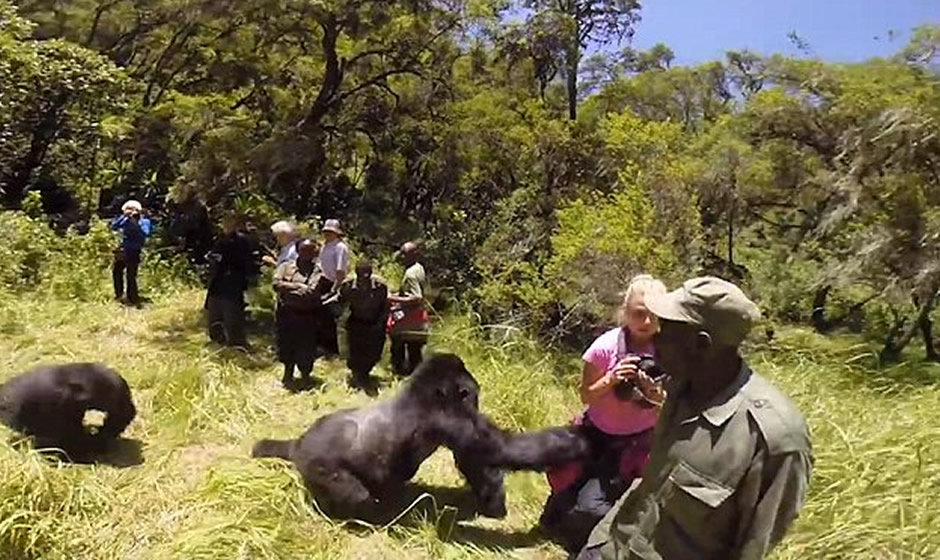A few days ago, an Australian tourist was knocked to the ground by a silverback gorilla while she was trekking the iconic species in the Volcanoes National Park.
The tourist, identified as Gemma Cosgriff (pictured above), was left in terror when the gorilla, which reportedly weighed about 300kg, rushed towards her and pushed her over.
Damian, Cosgriff’s husband, filmed the terrifying encounter and posted the video on YouTube. The video went viral.
Cosgriff said she suspected her pink T-shirt could have attracted the gorilla, describing the incident as a “once-in-a-lifetime” experience.
But a once-in-a-lifetime experience as it may have seemed to her, it could have gotten a little disastrous.
But what really attracted the gorilla to Cosgriff? Was it her pink T-shirt?
Well, we contacted someone who is well-versed with mountain gorilla behaviour to give us his opinion.
Dr. Jean Felix Kinani is the founder and executive director of One Health Approach for Conservation (OHAC), an organisation that focuses on research, training, consultancy and creating One Health and Conservation awareness. He has been working as a wildlife veterinarian and field epidemiologist across the Great Lakes Region since 2004.
Here is Dr Kinani: “Tourists should be asked not to wear shouting colours such as pink or red as such colours sting the gorillas’ eyes. They should put on green or black colours during visits to the park. In general, we need to avoid wearing or waving bright clothing.”
Talking of appropriate attire, it is also advisable that visitors wear long trousers, water proof jackets, gardening gloves, and walking boots, especially considering that the paths in the forest can sometimes be slippery and steep.
Dr Kinani, who spent 11 years working as a vet in the Volcanoes National Park, says that frequent contact between gorillas and tourists puts the animals in danger of contracting infectious diseases from humans.
“Sometimes it’s hard for tourists to follow visitation rules — especially the one that says that visitors should keep a minimum distance of seven metres from the gorillas — due to dense vegetation and steep paths,” notes Dr Kinani, who has researched extensively on the genetic relatedness of mountain gorillas and humans.
For those suffering from a cold, flu or any other contagious infection, Dr Kinani advises against trekking the gorillas because they are susceptible to catching human infections. His argument is that we share 98 per cent DNA with them yet they don’t have the immune system that humans have, meaning that a simple respiratory infection in a mountain gorilla could turn out to be life-threatening.
“Both great apes and humans can be infected with pathogens — such as ebola virus, shigella, tuberculosis, cryptosporidium and giardia — from other wild or domestic animals,” he offers.
As a preventive measure, some international conservationists have rooted for another rule that asks tourists to don face masks in order to protect the gorillas from human germs. However, Dr Kinani says that face masks are not necessary as they not only make tourists uncomfortable, but also scare away the animals. According to him, what Rwanda needs to put in place is a field laboratory to boost current preventive measures.
Dr Kinani also advises that caution should be taken whilst taking photos during gorilla trekking expeditions. Using big cameras with big lenses is not a good idea, he avers. Even though it is advisable to take off the flash, that alone may not be enough, according to Dr Kinani.
“The gorilla can see its reflection in a big camera lens and mistake it to be another gorilla and subsequently come over to take a closer look,” he says. “I once saw a young gorilla trying to touch its reflection in a water stream, thinking that there was another gorilla in the water.”
Bringing it all together, Dr Kinani advises gorilla trekkers to always take off their camera flashes, avoid making noise in the forest, avoid brisque movement, avoid pointing at the gorillas, look away when a gorilla makes eye contact, and go down if the gorilla charges.
“It is not recommended to keep eye contact with an adult gorilla for a long time as the gorilla might feel uncofortable and change its behaviour,” he says.
Dr Jean Felix Kinani is the founder and executive director of One Health Approach for Conservation (OHAC).
Email: jfkinani@gmail.com, ohac2004@gmail.com
